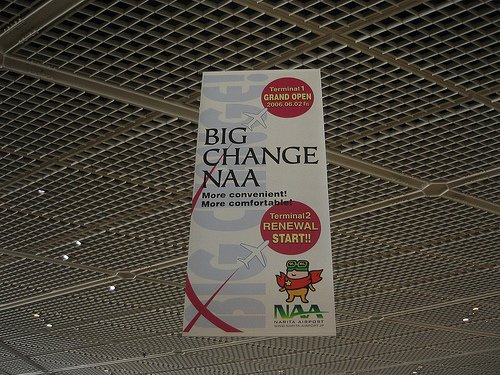Like Tokyo Disneyland, the New Tokyo International Airport is not located in Tokyo, being situated in Narita City, Chiba Prefecture, about an hour’s train ride from Japan’s capital. Back in the 1960s, Haneda Airport became unable to handle the country’s growing air traffic, and the government made plans to build a new airport in Chiba to handle the International side of things. The trouble is, no one consulted the farmers of the then-sleepy shrine town of Narita beforehand, and a massive fight over whether the nation has the right to force citizens to sell their land for the common good ensued, with plenty of violent protests by the farmers who didn’t want to be told what to do. The idea of “eminent domain” was not an established legal concept in Japan at the time, and the case is still not completely resolved. Ever since the 1980s (read: ever since Japan has been exerting a major cultural influence on the outside world), Narita has been the setting for the final scene of many a manga, anime or TV drama, including several that I used to study Japanese with. In all of these scenes, the unique metal tile ceiling of the Narita departure terminal (which you can see on the J-List site) can be seen. Every time I step foot inside the airport I look up at that ceiling, remembering the many emotional scenes that had unfolded there before.

I talked about kokuminsei (if you want kanji, 国民性) last time, the short list of features that ties each of us to our home country. Another facet of this “national personality” in Japan is the widely-used mantra shikata ga nai (仕方がない、sh-kah-tah ga NAH-ee), which translates as “it can’t be helped” and is used by Japanese whenever they face a difficult situation that they feel powerless against. Don’t like the current policies the government is adopting? Is there some aspect of society that you dislike? Just say shikata ga nai, or its more common version, sho ga nai (しょうがない, “there’s nothing I can do about that”), and you’ll feel better. It’s really the perfect excuse — you can even say shikata ga nai about stupid foreigners who think Japanese say shikata ga nai too much. In a country that crams half the population of the U.S. into an area the 1/25 the size, getting along is very important, and I guess these magic words help facilitate that harmony. On the other hand, there are times when people could do something about a particular problem, be it racism or sexism or the government’s wasting money on needless public works projects, but people are so used to saying that nothing can be done about a problem that it becomes a self-fulfilling prophecy.
A similar concept is the idea of gaman (gah-MAHN), which means to endure that which you can’t change. The ability to tolerate a bad situation without complaint is considered a very good quality for Japanese to have, and much of life in Japan involves sucking it in and putting up with the little things we wish were different. Apartments in Tokyo, often re-branded with the Japanese-English term “mansion” to make them sound more grandiose, are too small to comfortably raise a family. Cities are urban jungles, prices for many necessary products are high, the population of the country is projected to be just 27 at the end of the current millennium, and our local bank pays 0.02% interest per year on a 1-year CD. The only thing you can do when faced with such adversity is gaman, just put up with it without complaint, or you’d go crazy. As with the phrase shikata ga nai, which helps Japan get along more harmoniously but also causes people to fail to take action when it’s called for, gaman is both a stoic virtue as well as the source of problems. If you’ve got a pregnant wife and the restaurant manager apologizes that there isn’t a no smoking section for you to sit in, as happened to me years ago, it’s definitely not a gaman situation.
Here are today’s “really cool products” that I thought were especially noteworthy. Note: the J-List links below may be for adult products and should probably be considered “not safe for work.” To see all the J-List products, check out J-List or the JBOX.com updated products link.















